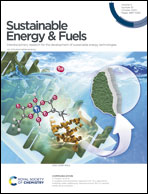Facile synthesis of SnO2 nanoparticle intercalated unzipped multi-walled carbon nanotubes via an ultrasound-assisted route for symmetric supercapacitor devices†
Abstract
Unzipped multi-walled carbon nanotubes have found applications in different fields, for example, as a catalyst substrate in organic reactions and battery applications. We report the ultrasound-assisted synthesis of unzipped multiwalled carbon nanotubes in the presence of a Lewis catalyst (SnCl2). In this reaction, Sn2+ cleaves the functional groups present in the nanotubes resulting in the formation of a nanosheet morphology by ring-opening, while Sn2+ gets oxidized to Sn4+ with simultaneous intercalation into the nanosheets preventing the restacking of sheets. The formation of UzMWCNTs/SnO2 nanosheets was characterized using SEM, TEM, XRD, FT-IR, UV-Vis, TGA, and Raman spectroscopic analyses. The electrochemical behaviour of UzMWCNTs/SnO2 nanosheets was analyzed using cyclic voltammetry, galvanostatic charge–discharge, and electrochemical impedance spectroscopy techniques, which showed a maximum specific capacitance of 351 F g−1 and 148 F g−1 in 1 M Na2SO4 and 6 M KOH, respectively at a 0.5 mA cm−2 current density. An improved discharge capacity and better stability over 3000 cycles were also observed.



 Please wait while we load your content...
Please wait while we load your content...